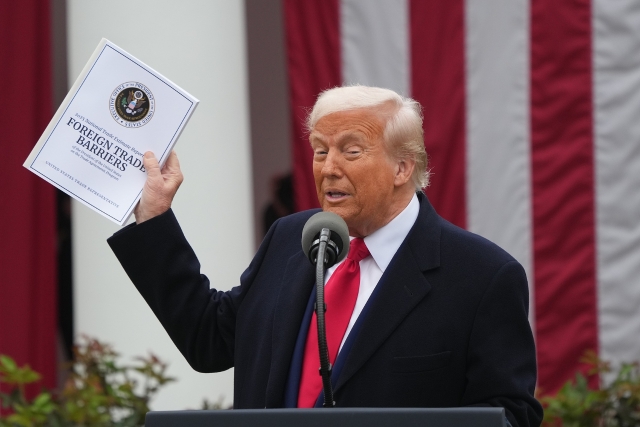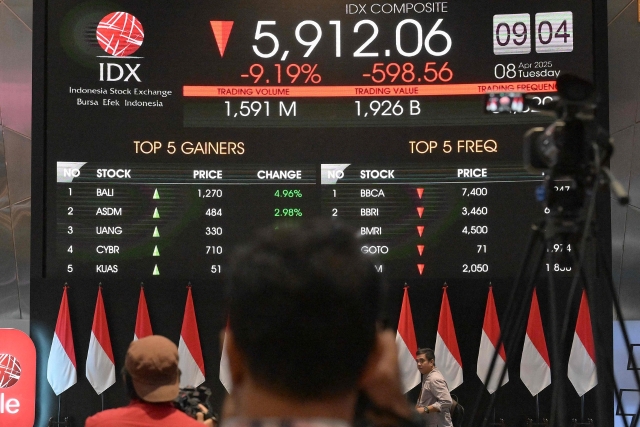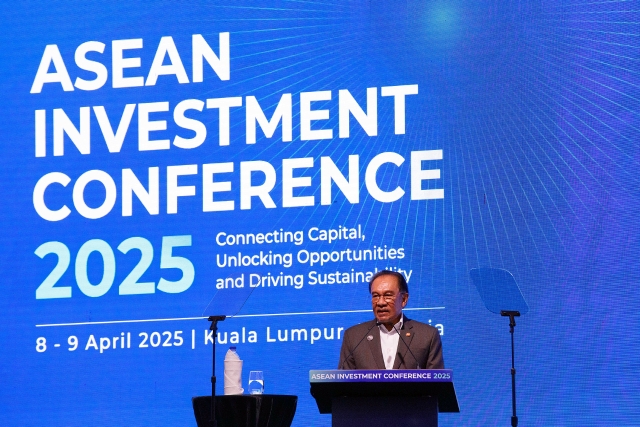
Donald Trump holds a “Foreign Trade Barriers” report as he makes remarks at a “Make America Wealthy Again” event in Washington, DC, on April 2, 2025. (CFP Photo)
Given the reciprocal tariffs imposed by U.S. President Donald Trump, which take effect on April 9, China and ASEAN member countries—the most heavily impacted—should seek to strengthen economic ties to safeguard promising Asia from further protectionist measures and extreme coercion.
According to a list of tariffs released by Washington on April 2, all ten ASEAN countries were singled out without exception, becoming victims of Trump's tariff sticks. Among them, three were the hardest-hit nations worldwide: Cambodia, which was slapped with a 49% tariff; Laos, with a 48% tariff; and Vietnam, with a 46% tariff.
There may be a reason for Trump, a shrewd deal maker, to take this action, as the U.S. has experienced trade deficits with many partners worldwide since 1976, which surged after the 2000s. This was an era marked by the emergence of economies such as China and ASEAN countries, which embraced globalization and adopted an export-oriented model to develop their economies.
However, in 2024, the U.S. trade deficit in goods reached approximately $1.2 trillion, according to data from the U.S. Commerce Department released in February. ASEAN countries' trade surplus in goods with the U.S. reached $227.7 billion, accounting for about 19% of the global trade surplus with the United States. Only Singapore has a trade deficit with the U.S. of $2.8 billion but is still subject to an original baseline 10% tariff.
Vietnam, Thailand, and Malaysia have the largest surpluses with the U.S. among ASEAN countries. Notably, Vietnam's surplus with the U.S. reached $123.5 billion in 2024, ranking third in the world, behind China and Mexico, making it a prominent target for U.S. tariffs.

People monitor the opening of the composite stock index at the Indonesia Stock Exchange in Jakarta on April 8, 2025. (CFP Photo)
Asia-Pacific stocks plunged on April 7 to levels not seen in decades, as global markets continued to panic over Trump's tariffs. Currently, ASEAN countries have not implemented retaliatory measures, leaving room for further negotiations with Washington. Malaysia, as the ASEAN chair this year, has been coordinating talks among its members to explore a common regional approach.
Vietnam and Indonesia have already sent senior trade officials to Washington, affirming their desire for fair trade to de-escalate the tension. On April 8, Malaysia announced plans to send a negotiating team to talk with the U.S. at the end of April. Thailand and Myanmar are conducting internal assessments, while Singapore is adopting a cautious stance on the tariffs, warning of the risks of being marginalized and left behind as a single country.
Nonetheless, as a region with a population of 678 million people and a GDP of approximately $3.9 trillion, ASEAN has maintained its position as China's largest trading partner for five consecutive years since 2020. Conversely, China has been ASEAN's largest trading partner for 16 consecutive years.
In 2024, the total trade value between China and ASEAN reached ¥6.99 trillion, marking an increase of 9% and accounting for 15.9% of China's total foreign trade. China's exports to ASEAN amounted to ¥4.17 trillion, while its imports from ASEAN totaled ¥2.82 trillion. Among ASEAN members, the top three trading partners for China are Vietnam, Malaysia, and Indonesia.

Anwar Ibrahim, Malaysia's Prime Minister, attended the ASEAN Investment Conference 2025 in Kuala Lumpur, Malaysia, on April 8, 2025. (CFP Photo)
Since the Regional Comprehensive Economic Partnership(RCEP)came into effect in 2022, China has eased import tariffs and has become one of the core export markets and sources of imports.
A report unveiled at the Boao Forum in late March indicated that developing economies in ASEAN, such as Laos, Myanmar, Cambodia, and Indonesia, have experienced the fastest growth rates, with their intra-regional trade increasing by 72.4%, 40.4%, 26.0%, and 19.2%, respectively, compared to the levels before RCEP came into force.
China has opened its agricultural market to ASEAN countries. Chinese customs data showed that the country imported a record-high 15.6 million tons of durian worth nearly $7 billion last year, with the largest share coming from ASEAN countries such as Thailand and Vietnam.
With China's access to more ASEAN agricultural products, agricultural cooperation in the region has also provided new economic opportunities for ASEAN countries. China has planned to import $150 billion worth of agricultural products from ASEAN over the next five years under the RCEP.
Additionally, this year marks the 15th anniversary of the establishment of the China-ASEAN Free Trade Area (ACFTA) and the debut of ACFTA 3.0, which concluded negotiations in October 2024. The 3.0 version consists of nine domains, covering both existing areas of ACFTA and emerging areas with significant cooperation potential between the two sides, such as the digital economy, green economy, and supply chain.
Correspondingly, Malaysia aims to complete negotiations on the ASEAN Digital Economy Framework Agreement (DEFA) by 2025, paving the way for regional digital technology integration and striving to position ASEAN as a world-leading digital economy.
An upgraded ACFTA 3.0 can align with DEFA's standards and rules to boost the digital economy of both sides. It is estimated that from the effective date of DEFA to 2030, the digital economy scale of ASEAN countries could increase to $2 trillion.
Given the increasing uncertainty of the global economy disrupted by Trump's universal tariffs, China aims to be a standard bearer of multilateral trade and seeks to work with ASEAN countries to secure an open, inclusive, and sustainable economy worldwide.
Author: Zhang Ruijun
Editor: Yuan Zixiang, James, Shen He
















